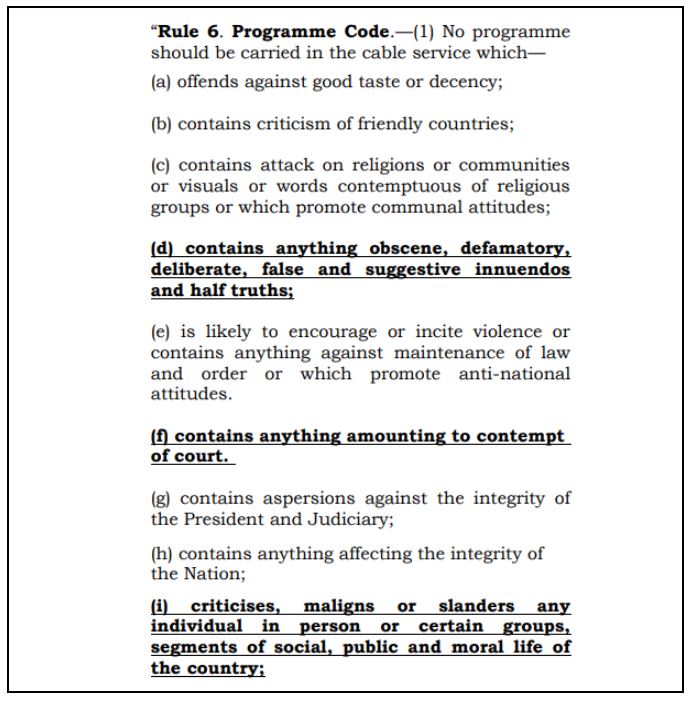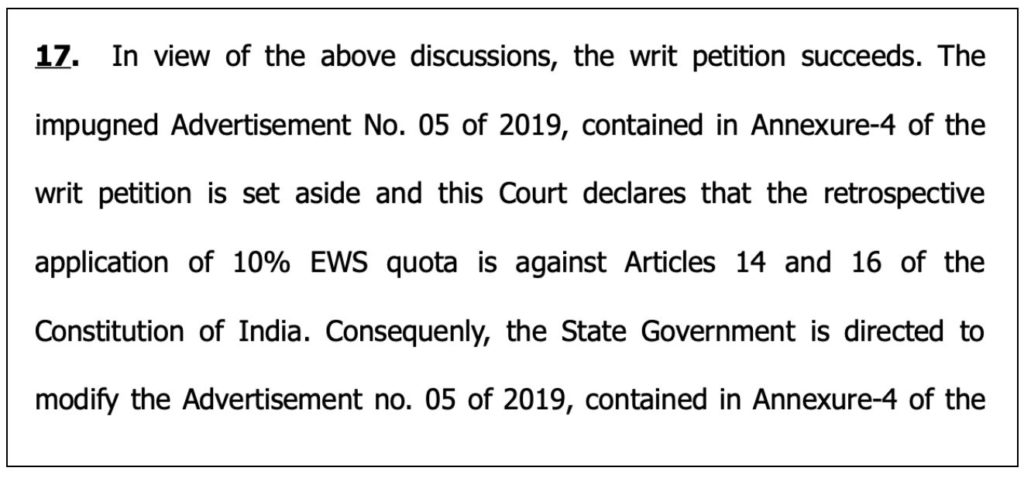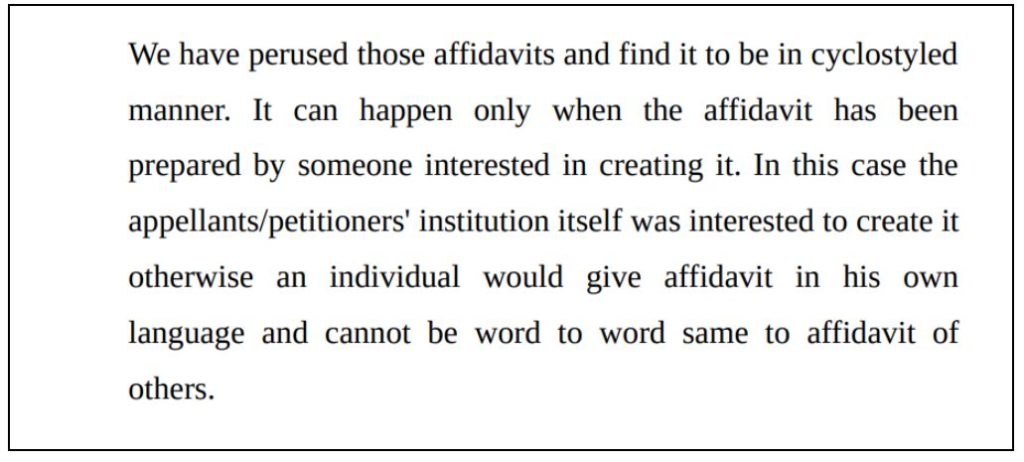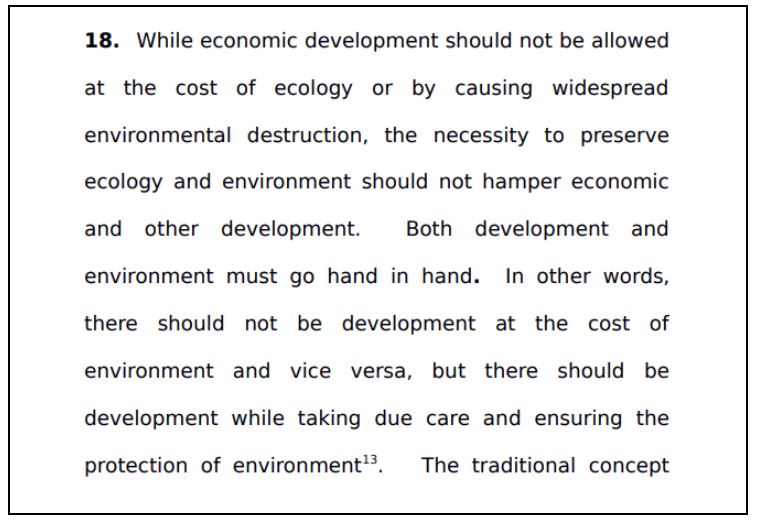In this edition of the roundup of important court judgments, we look at cases where constitutional courts made important observations & issued directions about what constitutes media trials, retrospective application of certain reservation laws, the status of education, and environmental clearance for highways.
Bombay HC: Media Trial during investigation interferes with administration of justice
In disposing of a batch of PILs seeking regulation of media trial, the Bombay high court made several important observations & issued directions on “media trial”, how it interferes with the administration of justice and hence amounts to ‘contempt of court’ as defined under the Contempt of Courts Act, 1971.
The judgement begins by expressing that the issue raises questions of contemporary importance touching upon the right of the press/media to express views freely, the right of the deceased to be treated with respect and dignity after death, the need to ensure investigation of the crime to proceed on the right track without being unduly influenced by media reports based on “investigative journalism”, and the right of the accused to a free and fair trial as well as the right not to be prejudged by the media.
With respect to the “administration of justice”, any report of the media, having the propensity of tilting the balance against fair and impartial “administration of justice”, could make a mockery of the justice delivery system rendering ‘truth’ a casualty. The duty of the media to have news items printed/telecast based on true and correct version relating to incidents worth reporting accurately and without any distortion/embellishment as well as without taking sides, cannot, therefore, be overemphasized.
The Division Bench of Chief Justice Dipankar Dutta and Justice GS Kulkarni also discussed the status of regulation of cable television networks in India with respect to the Cable TV Networks (Regulation) Act (CVTN) which were brought into effect from September 29, 1994. The ‘Programme Code’ enshrined in the Act is emphasised. One of our earlier articles discusses this in detail. They observed that media trial not only runs counter to the Program Code framed under the Cable TV Act but also interferes with the criminal investigation by police.

Considering the provisions of the CTVN Act and the CTVN Rules, and the Programme Code as stipulated under rule 6 of the CTVN Rules, the bench concluded that it would apply to the telecast which is in the nature of a media trial having adverse consequences on an ongoing criminal investigation. The bench expressed that the media ought to avoid/regulate certain reports/discussions touching upon any on-going investigation into a criminal offence and that no report/discussion/interview should be presented by the media which could harm the interests of the accused being investigated or a witness in the case or any such person who may be relevant for any investigation. The judgement highlights that over the last six months, several High Court has also expressed concerns over the practice of “media trial”.
Accordingly, the court directed the media to exercise restraint from printing/displaying any news item and/or initiating any discussion/debate/interview of nature, as indicated below;
- In relation to death by suicide, depicting the deceased as one having a weak character or intruding in any manner on the privacy of the deceased.
- That causes prejudice to an ongoing inquiry/investigation by
- Referring to the character of the accused/victim and creating an atmosphere of prejudice for both;
- Holding interviews with the victim, the witnesses, and/or any of their family members and displaying it on screen;
- Analyzing versions of witnesses, whose evidence could be vital at the stage of trial;
- Publishing a confession allegedly made to a police officer by an accused and trying to make the public believe that the same is a piece of evidence which is admissible before a Court and there is no reason for the Court not to act upon it, without letting the public know the nitty-gritty of the Evidence Act, 1872;
- Printing photographs of an accused and thereby facilitating his identification;
- Criticizing the investigative agency based on half-baked information without proper research;
- Pronouncing on the merits of the case, including pre-judging the guilt or innocence of an accused or an individual
- Recreating/reconstructing a crime scene and depicting how the accused committed the crime;
- Predicting the proposed/future course of action including steps that ought to be taken in a particular direction to complete the investigation; and
- Leaking sensitive and confidential information from materials collected by the investigating agency;
- Acting in any manner so as to violate the provisions of the Programme Code as prescribed under section 5 of the CTVN Act read with rule 6 of the CTVN Rules and thereby inviting contempt of court;
- Indulging in character assassination of any individual and thereby mar his reputation.
Based on such parameters, the Court also held that the media coverage by the Republic TV and Times Now against Mumbai police in the case pertaining to the death of late actor Sushant Singh Rajput is prima facie contemptuous.

Furthermore, the Bench has also held that the Press Council of India guidelines on reporting shall be applicable to the electronic media as well. It has directed all complaints regarding a programme’s contents to be dealt with immediacy by an authorized officer of the Central Government under the Cable TV Network Act without involving a private body like the National Broadcasting Standards Authority (NBSA) set up by the National Broadcasters Association.
Jharkhand HC: Retrospective application of 10% EWS quota is against Articles 14 and 16
In the case of Ranjeet Kumar Sah and Uttam Kumar Upadhyay vs. State of Jharkhand and others, the Jharkhand high court held that retrospective application of 10% EWS quota is against Articles 14 and 16 of the Constitution.
The issue in front of the court was that there were vacancies for the post of Assistant Engineer (Civil) in the year 2013 and pursuant to this, the advertisement was published in 2015. The number of unreserved posts advertised was 105 vacancies. There was no EWS reservation of 10% quota applicable at that point of time. The cut-off date for age eligibility was specified to be 01.08.2013 and it was also specified that the age of eligibility to participate will be 21 to 35. Though the selection process was initiated, the same was not concluded by way of a selection test. The department further published Advertisement No.05 of 2019 to make an appointment for the post of Assistant Engineer (Civil). The earlier advertisements were not completed and they have been superseded by the current advertisement, which contains merged vacancies of advertisements of 2013 and 2015 and also current vacancies of 2019.
The Government of India through an office memorandum dated 31.01.2019 published its decision of 10% reservation for EWS in direct recruitment in civil posts and services in the Government of India. The State of Jharkhand also introduced the reservation quota of 10% for EWS in the civil posts and services of the Government of Jharkhand. The amendment in the reservation rules of 2001, were brought into effect to the extent of increasing the percentage of reservations to 60%.
The petitioners submitted that since they are not EWS candidates, the applicability of reservation quota on this count is adversely affecting their right on earlier vacancies. Due to the merger of vacancies, the seats which were available in the year 2013 and 2015, have been brought under the cover of the current advertisement of the year 2019, wherein 10% reservation for EWS have been made applicable retrospectively for all the earlier vacancies, that were part of the earlier selection process. A total of 52 seats have been earmarked for EWS candidates separately, but these seats have been carved out from the unreserved quota but this has to be done on post facto vacancies.
The judgement clarifies that the court was not examining whether the reservation up to 60% is valid or not. The only question that was by the Court as to whether EWS reservation can be given effect retrospectively or not.
On that question, a single bench of Justice Sanjay Kumar Dwivedi held that the retrospective application of the 10% EWS quota is against Articles 14 and 16 of the Constitution of India. Consequently, the State Government is directed to modify the Advertisement of 2019 to the extent that 10% quota for EWS shall not be made effective retrospectively for the vacancies of the years 2013 and 2015. It was concluded that the ongoing appointment process is not based on constitutional mandate and therefore it is illegal.

Allahabad HC: Education in the state has been taken as a business or industry
In the case, Sai College of Education and another vs. the State of UP, the high court made strong remarks on the status of education in Uttar Pradesh, which the court hold has been taken as a business or industry.
The matter before the court was with regards to the admission of twenty-five students in B.Ed. course. The facts on record show that twenty-five candidates belonging to the Scheduled Castes and Scheduled Tribes were recommended for admission through centralized counseling. None of the candidates, so recommended, was given admission rather appellants/petitioners’ institution admitted other twenty-five students.
By way of an appeal, a challenge was made to the judgment dated December 2020 whereby the writ petition preferred by the appellants/petitioners (Education Institutions) was dismissed.
To justify their action, the appellant/ petitioners (Education Institutions) held that the candidates named for the admission in the centralized counseling were not inclined to take admission and for that, a copy of the affidavit of few candidates was enclosed. The court pursued the affidavits and found it to be in a cyclostyled manner.

The Bench of Justice Munishwar Nath Bhandari and Justice Rohit Ranjan Agarwal observed that the affidavits were obtained by appellants/petitioners’ institution containing the same language which cannot happen if it is to be given by different candidates on different dates. The affidavits having the same language were created at the instance of the appellants/petitioners’ institution and seem to have been given to get a refund of the amount paid online. Most importantly, the fact further remains that out of twenty- five candidates/students recommended for admission, it cannot be that none would take admission. The court took a strong stance at the state of education in Uttar Pradesh and expressed the following:

In conclusion, the high court did not find any illegality in the judgment of the Single Judge and dismissed the appeal challenging the earlier judgment.
The court was inclined to send the matter to the National Council for Teacher Education (N.C.T.E.) for appropriate action which includes de-recognition of the institution looking to their conduct, but for the reason that N.C.T.E. is not a party to this appeal as well as to the petition, the Court refrained to take suo-moto cognizance but warned the institution not to indulge in the practice of nature referred herein.
Supreme Court: Segmentation of project as a strategy to avoid environmental clearance not permissible
In the case of the National Highways Authority of India vs. Pandarinathan Govindarajulu and others, the apex court while observing the there was no requirement for obtaining environmental clearance for NH-54 A, held that segmentation of a project cannot be adopted as a strategy to avoid environmental clearance impact assessment.
The matter was regarding the environmental clearance for expansion of National Highway 45-A between Villuppuram to Nagapattinam. The project of widening and improvement of the existing 4-lane carriageway in the State of Tamil Nadu and the Union Territory of Puducherry was bifurcated into four packages. Approval was granted by the Competent Authority, i.e. Special District Revenue Officer (Land Acquisition), National Highways No. 45-A in March 2018. The process was initiated for the acquisition of lands required for the project.
Writ Petitions were filed in the High Court of Madras by certain aggrieved farmers and public interest litigants questioning the commencement of the project without obtaining environmental clearance.
Upon reviewing all the submissions, the apex court held that there is no requirement for obtaining environmental clearances for NH 45-A Villuppuram -Nagapattinam Highway as land acquisition is not more than 40 meters on existing alignments and 60 meters on realignments or bypasses. In doing so, the apex court set aside the Madras High Court judgment which had held that it is necessary.
The bench of Justice L. Nageswara Rao, Hemant Gupta, and Ajay Rastogi also observed that the adoption of segmentation of a project cannot be adopted as a strategy to avoid environmental clearance impact assessment. Therefore, it directed the Ministry of Environment, Forest and Climate Change, Government of India to constitute an Expert Committee to examine whether segmentation is permissible for National Highway projects beyond a distance of 100 kms and, if permissible, under what circumstances.
The bench also directed NHAI to strictly conform to the EIA notifications in the matter of acquisition of land being restricted to 40 meters on the existing alignments and 60 meters on realignments, and also to fulfill the requirement of reafforestation in accordance with the existing legal regime.
The bench emphasised that development and the environment must go hand in hand.

Featured Image: Important court judgments


